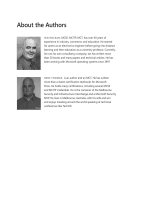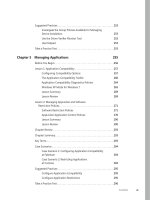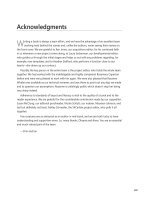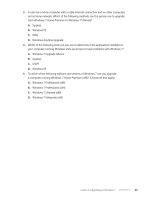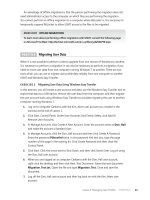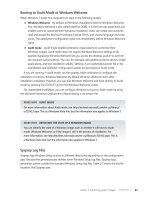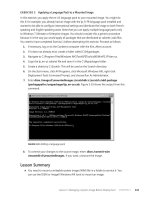Configuring Windows 7 (Training Kit) - Part 10 pot
Bạn đang xem bản rút gọn của tài liệu. Xem và tải ngay bản đầy đủ của tài liệu tại đây (302.18 KB, 10 trang )
Lesson 1: Capturing System Images CHAPTER 2 63
CONFIGURATION
PASS FEATURE VALUE
oobeSystem x86_Microsoft-Windows-
Deployment_6-1.<build>_
neutral
Id = x86_Microsoft-
Windows-Deployment__
neutral_<guid>_nonSxS
oobeSystem x86_Microsoft-Windows-
Shell-Setup_6-1.<build>_
neutral
BluetoothTaskbarlconEnabled
= true
DisableAutoDaylightTimeSet
= false
DoNotCleanTaskBar = true
RegisteredOrganization
= Microsoft
RegisteredOwner = Microsoft
ShowWindowsLive = true
StartPanelOff = true
TimeZone = EST
FIGURE 2-4 The Windows SIM dialog box with feature values
13. If you want, you can expand the feature and alter further sets of feature values from
their defaults. Figure 2-5 shows this option.
64 CHAPTER 2 Configuring System Images
FIGURE 2-5 Altering default values
These settings define a basic unattended installation in which no user input is required
during Windows Setup. When the installation is complete, the computer will reboot to audit
mode. This enables you to boot quickly to the desktop, install additional applications and
device drivers, and test the installation. Windows Welcome does not run in audit mode, but it
will run the next time the computer restarts if you run the sysprep /oobe command. Windows
Welcome, also called Machine OOBE, prompts the user to read the Microsoft Software
License Terms and to configure the computer.
More Info AUDIT MODE AND SYSPREP
For more information about audit mode, see />cc722413.aspx. For more information about the Sysprep utility, see />en-us/library/cc766049.aspx.
Validating and Saving Settings
To validate the settings in your answer file and save them to a file on removable media,
perform the following procedure:
1. Click Tools in Windows SIM and then choose Validate Answer File.
2. Warnings that state that default settings have not been changed will not prevent the
file from being validated or saved. If error messages or other warnings appear in the
Messages pane, you need to check your settings.
Lesson 1: Capturing System Images CHAPTER 2 65
3. If an error occurs, double-click the error message in the Messages pane to navigate
to the incorrect setting. Change the setting to fix the error, and then validate again by
choosing Tools, Validate Answer File. Repeat this step until the answer file validates.
4. On the File menu, choose Save Answer File. Save the answer file as Autounattend.xml.
Figure 2-6 shows a portion of an Autounattend.xml file.
FIGURE 2-6 An Autounattend.xml file
5. Copy the Autounattend.xml file to the root directory of a removable storage device
(such as a UFD). You now have a basic answer file that automates Windows Setup.
More Info BUILDING ANSWER FILES
For more information about building answer files, see />library/cc748874.aspx. This is a Windows Vista link, but the information also applies to
Windows 7.
Building a Reference Installation
You configure your reference computer with a customized installation of Windows 7 that
you then duplicate onto one or more destination computers. You can create a reference
installation by using the Windows product DVD and (optionally) the answer file you created
in the previous section. To install your reference computer using an answer file, perform the
following procedure:
1. Turn on the reference computer. Insert the Windows 7 product DVD and the UFD
containing the answer file (Autounattend.xml) that you created in the previous section.
Note that the use of an answer file is optional, although it is the method Microsoft
recommends. If you prefer, you can install Windows 7 manually from the installation
DVD-ROM.
66 CHAPTER 2 Configuring System Images
2. Restart the computer by pressing CTRL+ALT+DEL. You may have to override the boot
order to boot from the CD/DVD-ROM disk. If so, select the appropriate function
key to override the boot order during initial boot. Windows Setup (Setup.exe) starts
automatically and searches the root directory of all removable media for an answer file
called Autounattend.xml.
3. After Setup finishes, you can validate that all customizations were applied. For
example, if you included the optional Microsoft-Windows-IE-InternetExplorer feature
and set the Home_Page setting in your answer file, you can verify these settings by
opening Internet Explorer.
note INSTALLING A SMALL NUMBER OF CLIENT COMPUTERS
If you want to install only a very small number of client computers, say five or less,
you can simply repeat the installation using the DVD-ROM installation disk and the
Autounattend.xml file on each computer in turn. However, for a larger number of
computers, it is more efficient to create a WIM image and distribute it. To do this, the
reference computer needs to be prepared for the end user.
4. To prepare the reference computer for the user, you use the Sysprep utility with the
/generalize option to remove hardware-specific information from the Windows
installation and the /oobe option to configure the computer to boot to Windows
Welcome upon the next restart. Open an elevated command prompt on the reference
computer and run the following command:
c:\windows\system32\sysprep\sysprep.exe /oobe /generalize /shutdown
Sysprep prepares the image for capture by cleaning up various user-specific and
computer-specific settings, as well as log files. The reference installation now is complete and
ready to be imaged.
CautIon OUT-OF-BOX DEVICE DRIVERS
When you run the sysprep /generalize command, out-of-box device drivers are removed from
the Windows image. If you add out-of-box device drivers during installation and you intend
to capture the Windows image that includes these drivers, set the PersistAllDeviceInstalls
setting of the Microsoft-Windows-PnpSysprep feature to True in the answer file.
Creating a Bootable Windows PE Medium
In this step, you create a bootable Windows PE CD-ROM or DVD-ROM disk by using the
Copype.cmd script. Windows PE enables you to start a computer for the purposes of
deployment and recovery by booting directly into memory. You can remove the Windows PE
media after the computer boots. After you have booted into Windows PE, you can use the
ImageX tool to capture, modify, and apply file-based disk images.
Lesson 1: Capturing System Images CHAPTER 2 67
note USING A BOOTABLE WINDOWS PE DISK TO CREATE AN IMAGE ON VHD
You use Windows PE if you are capturing the image of a computer running Windows 7
Enterprise or Ultimate to install on a bootable VHD. You do this in the practice in Lesson 2.
You will therefore be carrying out this procedure in the practice exercise.
More Info DEPLOYMENT TOOLS TECHNICAL REFERENCE
For more information about Microsoft deployment tools, see />en-us/library/cc766376.aspx.
To create a bootable Windows PE CD-ROM or DVD-ROM disk and install the ImageX
Windows AIK tool on that disk, perform the following procedure:
1. On your technician computer, create a local Windows PE build directory. Open an
elevated command prompt and enter the following commands:
cd C:\Program Files\Windows AIK\Tools\PETools\
copype.cmd <architecture> <destination>
Here <architecture> can be x86, amd64, or ia64, and <destination> is a path to the
local directory. For example, to create a Windows PE build directory winpe_86 on an
x86 computer, you enter the following command:
copype.cmd x86 C:\winpe_x86
2, Copy ImageX into the Iso subdirectory of your Windows PE build directory. On an x86
computer, you enter the following command:
copy "C:\program files\Windows AIK\Tools\x86\imagex.exe" C:\winpe_x86\iso\
3. Optionally, create a configuration file called Wimscript.ini by using a text editor such as
Windows Notepad. The configuration file instructs the ImageX tool to exclude certain
files during the capture operation (for example, Pagefile.sys or all .zip files). Figure 2-7
shows a Wimscript.ini file.
FIGURE 2-7 A Wimscript.ini file
68 CHAPTER 2 Configuring System Images
4. Save the configuration file to the Iso subdirectory of the Windows PE build directory.
The ImageX tool will recognize a Wimscript.ini file in the same location.
eXaM tIP
No command exists that instructs ImageX to detect a Wimscript.ini file. The ImageX tool
automatically detects Wimscript.ini if it is saved to the same folder as the ImageX tool.
5. Create an image (.iso) file by using the Oscdimg tool. For example, on an x86 computer
you would click All Programs, Microsoft Windows AIK, open the Deployment Tools
Command Prompt, and enter the following:
oscdimg -n –bc:\winpe_x86\etfsboot.com Cc:\winpe_x86\ISO
c:\winpe_x86\winpe_x86.iso
More Info ETFSBOOT.COM
This specifies the location of the El Torito boot sector file. For more information, see
Note also there is no space
between the –b flag and C:\Winpe_x86\Etfsboot.com.
6. Burn the image (Winpe_x86.iso) to a CD-ROM or DVD-ROM disk. Windows AIK does
not include CD/DVD-ROM burning software. Use trusted third-party software to
burn the image to optical media. You now have a bootable Windows PE optical disk
containing the ImageX tool.
Capturing the Installation onto a Network Share
You can capture an image of your reference computer by using Windows PE and the ImageX
tool. Then you store that image on a network share. Alternatively, on a computer running
Windows 7 Enterprise or Ultimate edition, you can store the image on a VHD and make that
VHD bootable, as described in the practice in Lesson 2, later in this chapter.
To capture the installation image you have created on your reference computer to
a network share, perform the following procedure:
1. Insert your Windows PE media into your reference computer and restart the computer.
As before, you may have to override the boot order to boot from the CD/DVD-ROM
drive. If so, select the appropriate function key to override the boot order during
initial boot.
2. Windows PE starts and opens a command-prompt window. Use the ImageX tool
located on your Windows PE media to capture an image of your reference computer
installation. For example, if your optical drive is drive E:, your installation is on drive C:,
and you want to capture the image on drive D:, you would enter:
e:\imagex.exe /capture C: d:\installationimage.wim "my Win7 Install" /compress
fast /verify
Lesson 1: Capturing System Images CHAPTER 2 69
3. Copy the image to a network location. For example, enter:
net use y: \\network_share\images
copy d:\myimage.wim y:
4. If necessary, provide network credentials for appropriate network access. Your image is
now on volume Y:.
Deploying from a Network Share
After you have imaged your reference installation, you can deploy the image onto new
hardware (one or more destination computers). This section describes how you would do
this manually. Chapter 3 discusses MDT 2010 and the automatic installation of multiple client
computers.
To deploy an image from a network share, you use the Diskpart tool to format the hard
drive of a destination computer. Then you copy the image from the network share. Perform
the following procedure:
1. On your destination computer, insert your Windows PE media and restart the
computer by pressing the CTRL+ALT+DEL keys. Windows PE opens a command-prompt
window.
2. Format the hard drive to reflect the disk configuration requirements by using the
Diskpart tool from the Windows PE command-prompt window. To do this, open an
elevated command prompt.
3. Enter diskpart.
4. Enter select disk 0.
5. Enter clean.
6. Enter create partition primary size=100.
7. Enter select partition 1.
8. Enter format fs=ntfs label=”system”.
9. Enter assign letter=c.
10. Enter active.
note SYSTEM PARTITION
Steps 6 through 9 create a 100-MB system partition. This is not strictly necessary
because the Windows 7 installation routine creates a system partition automatically
on installation if one has not been created already. However, Microsoft recommends
creating this partition before installation.
11. Enter create partition primary.
12. Enter select partition 2.
70 CHAPTER 2 Configuring System Images
13. Enter format fs=ntfs label=”Windows”.
14. Enter assign letter=d.
15. Enter exit.
note CREATING A SCRIPT
You can create a script with this information in a text file and store in the same location
as your image. To run the script from a Windows PE command-prompt window,
enter diskpart /s <scriptname>.txt, where <scriptname> is the name of the text file
that includes the Diskpart commands. Figure 2-8 shows a typical script file named
DiskConfigurationFormat.txt.
FIGURE 2-8 A disk configuration format file
16. Copy the image from the network share to your local hard drive. For example, at an
elevated command prompt, type:
net use y: \\network_share\images
copy y:\installationimage.wim d:
17. If necessary, provide network credentials for appropriate access.
18. Apply the image to the hard drive by using the ImageX tool located on the Windows
PE media. For example, at an elevated command prompt, enter:
e:\imagex.exe /apply d:\myimage.wim 1 C:
19. Use BCDboot to initialize the Boot Configuration Data (BCD) store and copy boot
environment files to the system partition. For example, at a command prompt, type:
d:\windows\system32\bcdboot d:\windows
Lesson 1: Capturing System Images CHAPTER 2 71
More Info BCDBoot
For more information about BCDboot, see />cc721886.aspx.
Your custom image is now deployed onto your destination computer. The computer is
ready for customer delivery. Repeat this procedure for each additional computer that you
configure.
More Info WINDOWS 7 DEPLOYMENT
For more information about installing and preparing a reference computer, including the
use of the Windows SIM tool to prepare answer files for automatic installation,
see
note CROSS-ARCHITECTURE TOOLS
Both ImageX (x86) and Windows PE (x86) and are cross-architecture tools. You can capture
both 32-bit and 64-bit images using these utilities.
eXaM tIP
Know the functions of a Wimscript.ini, disk configuration format, and Autounattend.
xml file. Know how these files are created, how they are accessed, and when you would
use them.
Windows Imaging Format
You can use the ImageX Windows AIK tool to create a WIM file that images a reference
computer. Unlike ISO files, which are used to contain images of operating systems and toolkits
across an intranet or the Internet, WIM is a file-based disk image format that contains a set of
files and associated file system metadata. However, unlike sector-based formats (such as ISO)
used for CD-ROM and DVD-ROM images, WIM is file-based, which means that the smallest
unit of information in a WIM image is a file. A file-based image is hardware-independent and
provides unique single-instance storage of a file that can be referenced multiple times in the
file system tree.
The files are stored inside a single WIM database. The resource cost of reading or writing
many thousands of individual files on a local disk is reduced by hardware- and software-
based disk caching and sequential data reads and writes. WIM images are deployed to an
existing volume or partition because the toolset does not create low-level disk structures, nor
does it format them. Instead, the Microsoft command-line tool Diskpart is used to create and
format volumes on the target computer.
72 CHAPTER 2 Configuring System Images
WIM files can contain multiple disk images, which are referenced either by a numerical
index or a unique name. Because WIM uses single-instance storage, information common
to more than one image is stored only once. Thus, as more images are added, each typically
takes up less disk space than did the first image. A WIM can be split (or spanned) into multiple
parts. Spanned WIM image parts have a .swm extension.
A WIM image can also be mounted as a new volume under Windows with a drive letter
associated with it to facilitate easier extraction or updating of its contents. The WimFltr.sys
device driver needs to be loaded before a WIM image can be mounted using ImageX.
The Wimgapi.dll dynamic link library provides a set of public application programming
interfaces (APIs) for manipulating WIMs. A number of third-party applications include the
capability to read or write WIM files. You can make WIM images bootable by using the
ImageX tool, this time with the /boot switch.
Quick Check
1. What file can you create, if you want, to instruct the ImageX tool to exclude
specified files and folders when capturing a system image?
2. How does ImageX detect this file?
Quick Check Answer
1. The Wimscript.ini file.
2. You save the file in the same folder as the ImageX tool (Imagex.exe), and ImageX
detects it automatically.
Distributing an Image to Many Computers
This section describes how you capture a WIM image from a reference computer and
distribute it manually to one or more destination computers. However, if you have a large
number of destination computers, manual distribution would be tedious and time consuming.
To avoid this, you need an automated method of simultaneously distributing an image to
many computers on your network.
Chapter 1 introduced Windows Deployment Services (WDS). This is suitable for destination
computers that boot from PXE. If you want to use WDS to distribute an image to a non-PXE
computer, you need to boot that computer into a WDS capture image. WDS images are
discussed later in this lesson.
Windows 7 introduces MDT 2010, which is a powerful tool for distributing system images
to multiple destination computers. Chapter 3 discusses MDT 2010 in some detail, but it is
appropriate to introduce the tool briefly in this chapter.
